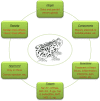Toad venom-derived bufadienolides and their therapeutic application in prostate cancers: Current status and future directions
- PMID: 37007051
- PMCID: PMC10060886
- DOI: 10.3389/fchem.2023.1137547
Toad venom-derived bufadienolides and their therapeutic application in prostate cancers: Current status and future directions
Abstract
Cancer is the second leading cause of death worldwide. Specially, the high incidence rate and prevalence of drug resistance have rendered prostate cancer (PCa) a great threat to men's health. Novel modalities with different structures or mechanisms are in urgent need to overcome these two challenges. Traditional Chinese medicine toad venom-derived agents (TVAs) have shown to possess versatile bioactivities in treating certain diseases including PCa. In this work, we attempted to have an overview of bufadienolides, the major bioactive components in TVAs, in the treatment of PCa in the past decade, including their derivatives developed by medicinal chemists to antagonize certain drawbacks of bufadienolides such as innate toxic effect to normal cells. Generally, bufadienolides can effectively induce apoptosis and suppress PCa cells in-vitro and in-vivo, majorly mediated by regulating certain microRNAs/long non-coding RNAs, or by modulating key pro-survival and pro-metastasis players in PCa. Importantly, critical obstacles and challenges using TVAs will be discussed and possible solutions and future perspectives will also be presented in this review. Further in-depth studies are clearly needed to decipher the mechanisms, e.g., targets and pathways, toxic effects and fully reveal their application. The information collected in this work may help evoke more effects in developing bufadienolides as therapeutic agents in PCa.
Keywords: current status; future directions; prostate cancers; therapeutic application; toad venom-derived bufadienolides.
Copyright © 2023 Ye, Zhou, Han and Zheng.
Conflict of interest statement
The authors declare that the research was conducted in the absence of any commercial or financial relationships that could be construed as a potential conflict of interest.
Figures



Similar articles
-
Isolation, Identification and Chemical Modification of Bufadienolides from Bufo melanostictus Schneider and Their Cytotoxic Activities against Prostate Cancer Cells.Molecules. 2024 Mar 31;29(7):1571. doi: 10.3390/molecules29071571. Molecules. 2024. PMID: 38611850 Free PMC article.
-
An overview of the past decade of bufalin in the treatment of refractory and drug-resistant cancers: current status, challenges, and future perspectives.Front Pharmacol. 2023 Oct 4;14:1274336. doi: 10.3389/fphar.2023.1274336. eCollection 2023. Front Pharmacol. 2023. PMID: 37860119 Free PMC article. Review.
-
Chemical profiling and cytotoxicity assay of bufadienolides in toad venom and toad skin.J Ethnopharmacol. 2016 Jul 1;187:74-82. doi: 10.1016/j.jep.2016.03.062. Epub 2016 Apr 6. J Ethnopharmacol. 2016. PMID: 27063985
-
Anti-tumor effects and 3D-quantitative structure-activity relationship analysis of bufadienolides from toad venom.Fitoterapia. 2019 Apr;134:362-371. doi: 10.1016/j.fitote.2019.03.006. Epub 2019 Mar 12. Fitoterapia. 2019. PMID: 30872126
-
Toad venom: A comprehensive review of chemical constituents, anticancer activities, and mechanisms.Arch Pharm (Weinheim). 2021 Jul;354(7):e2100060. doi: 10.1002/ardp.202100060. Epub 2021 Apr 22. Arch Pharm (Weinheim). 2021. PMID: 33887066 Review.
Cited by
-
Cinobufagin: Unveiling the hidden bufadienolide's promise in combating alimentary canal cancer development and progression - a comprehensive review.Naunyn Schmiedebergs Arch Pharmacol. 2025 Jul;398(7):8075-8089. doi: 10.1007/s00210-025-03902-9. Epub 2025 Feb 20. Naunyn Schmiedebergs Arch Pharmacol. 2025. PMID: 39976716 Review.
-
Isolation, Identification and Chemical Modification of Bufadienolides from Bufo melanostictus Schneider and Their Cytotoxic Activities against Prostate Cancer Cells.Molecules. 2024 Mar 31;29(7):1571. doi: 10.3390/molecules29071571. Molecules. 2024. PMID: 38611850 Free PMC article.
-
Pharmacological insights and role of bufalin (bufadienolides) in inflammation modulation: a narrative review.Inflammopharmacology. 2024 Oct;32(5):3057-3077. doi: 10.1007/s10787-024-01517-9. Epub 2024 Jul 16. Inflammopharmacology. 2024. PMID: 39012431 Review.
-
Pharmacological Effects of Cinobufagin.Med Sci Monit. 2023 Sep 25;29:e940889. doi: 10.12659/MSM.940889. Med Sci Monit. 2023. PMID: 37743616 Free PMC article.
-
Probing the role of Coniferin and Tetrahydrocurcumin from Traditional Chinese medicine against PSAT1 in early-stage ovarian cancer: An in silico study.PLoS One. 2025 Feb 6;20(2):e0313585. doi: 10.1371/journal.pone.0313585. eCollection 2025. PLoS One. 2025. PMID: 39913473 Free PMC article.
References
Publication types
LinkOut - more resources
Full Text Sources
Miscellaneous

